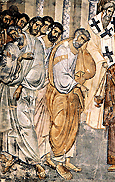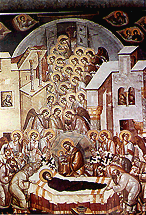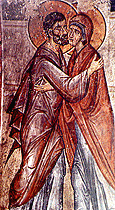 |
|
 |
Painting from 1261 to c.1300
 One of the most outstanding works in the
One of the most outstanding works in the
 monumental-plastic mode, which was inspired by the Classical tradition and which had already begun to take shape during the first half of the century, is the mosaic composition of the
Deesis
in the south gallery of the church of Hagia Sophia in Constantinople.
The superb frescoes in the church of the Holy Trinity in Sopocani (1265), Serbia, follow the same tendency. The three-dimensional rendering of the architectural elements, the sense of space, the painterly modelling and the statuesque forms are the features that characterise the scenes of this important monument and herald the stylistic developments to come. monumental-plastic mode, which was inspired by the Classical tradition and which had already begun to take shape during the first half of the century, is the mosaic composition of the
Deesis
in the south gallery of the church of Hagia Sophia in Constantinople.
The superb frescoes in the church of the Holy Trinity in Sopocani (1265), Serbia, follow the same tendency. The three-dimensional rendering of the architectural elements, the sense of space, the painterly modelling and the statuesque forms are the features that characterise the scenes of this important monument and herald the stylistic developments to come.
Of equal quality and similar style are the wall paintings of the church of Hagia Sophia in Trebizond, the capital city of the state of the
Grand Komnenoi.
The church was founded by the emperor Manuel I (1238-1263)and was probably decorated in the second half of the century.
The first phase of the wall paintings in the Metropolis (cathedral) of
 Mistra, which dates from 1270-85, represents the next stage in the development of Byzantine art. Here are to be found the first examples of the so-called heavy or "volume" style. The robust angels in the
diakonikon
are characteristic of the new tendency. Mistra, which dates from 1270-85, represents the next stage in the development of Byzantine art. Here are to be found the first examples of the so-called heavy or "volume" style. The robust angels in the
diakonikon
are characteristic of the new tendency.
The volume style is also represented in the capital of the Empire by the frescoes of the martyrion of St Euphemia and the splendid mosaics in the Vefa
Kilise Camii.
 The dominance of geometric shapes and the three-dimensional rendering of the figures and of the architectural elements are the basic characteristics of this style. The volume style reached its peak at the end of the century with representative examples such as the frescoes of the churches of St Kliment (Virgin Peribleptos) of Ohrid (1294/5), and of the Protaton at Mount Athos. The widespread dissemination of this style of painting is evidenced by the fact that we find representative works as far south as Elasson in central Greece, in the church of the Olympiotissa, and in churches in the Latin-occupied areas, such as the Omorphe Ekklesia in Athens. In both these examples, the paintings are of an exceptionally high quality. The dominance of geometric shapes and the three-dimensional rendering of the figures and of the architectural elements are the basic characteristics of this style. The volume style reached its peak at the end of the century with representative examples such as the frescoes of the churches of St Kliment (Virgin Peribleptos) of Ohrid (1294/5), and of the Protaton at Mount Athos. The widespread dissemination of this style of painting is evidenced by the fact that we find representative works as far south as Elasson in central Greece, in the church of the Olympiotissa, and in churches in the Latin-occupied areas, such as the Omorphe Ekklesia in Athens. In both these examples, the paintings are of an exceptionally high quality.
|
 Mistra, which dates from 1270-85, represents the next stage in the development of Byzantine art. Here are to be found the first examples of the so-called heavy or "volume" style. The robust angels in the
Mistra, which dates from 1270-85, represents the next stage in the development of Byzantine art. Here are to be found the first examples of the so-called heavy or "volume" style. The robust angels in the